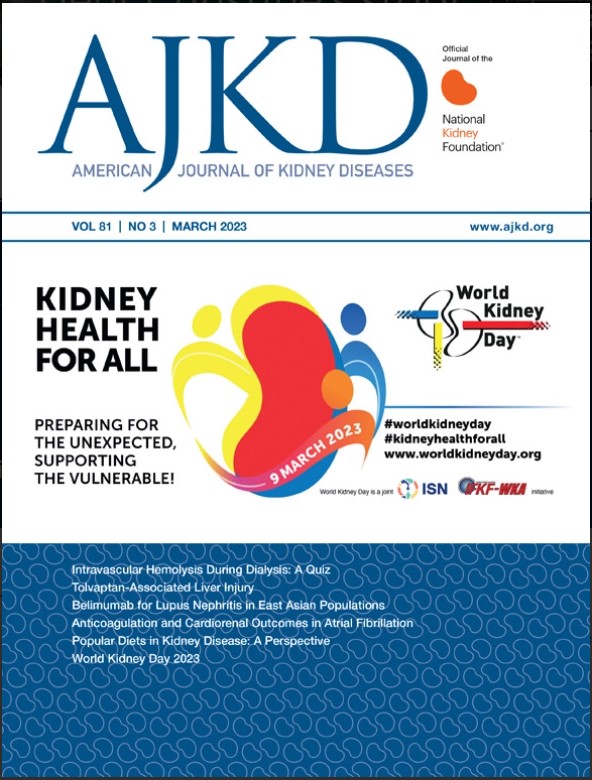Incidence and Adverse Outcomes of Acute Kidney Disease: A Systematic Review and Meta-Analysis
IF 8.2
1区 医学
Q1 UROLOGY & NEPHROLOGY
引用次数: 0
Abstract
Rationale & Objective
Estimates of the incidence of acute kidney disease (AKD) and its associated adverse outcomes are inconsistent, which may be due in part to differences in prior studies’ definitions of AKD. This study sought to summarize these reports and identify study-level characteristics, including the definition of AKD, that may explain the observed heterogeneity.
Study Design
Systematic review and meta-analysis.
Setting & Study Populations
Adults aged ≥18 years and not receiving maintenance kidney replacement therapy.
Selection Criteria for Studies
Observational studies that assessed the incidence of AKD and its association with adverse outcomes.
Data Extraction
Two reviewers independently extracted data and assessed study quality.
Analytical Approach
AKD definitions were classified as (1) Acute Disease Quality Initiative (ADQI) or ADQI-equivalent or (2) KDIGO (Kidney Disease: Improving Global Outcomes) or KDIGO-equivalent. A random-effects meta-analysis was used to calculate pooled estimates of incidence and the relationship between AKD and outcomes (mortality, kidney failure, onset of chronic kidney disease) summarized by ORs and 95% CIs.
Results
Among 1,883 identified studies, 59, involving nearly 6 million participants, met the inclusion criteria. Most studies were classified as being of good quality per the Newcastle-Ottawa scale (n = 44). The pooled incidence of AKD was higher when defined by ADQI/ADQI-equivalent criteria compared with KDIGO/KDIGO-equivalent criteria (26.6% [95% CI, 20.3-34.9%] vs 11.1% [95% CI, 7.6-16.3%]; P < 0.001). The pooled OR of all-cause mortality associated with AKD was similar whether defined with KDIGO/KDIGO-equivalent or ADQI/ADQI-equivalent criteria (3.8 [95% CI, 2.2-6.7] vs 3.0 [95% CI, 2.1-4.4]; P = 0.5). After accounting for baseline acute kidney injury status, the incidence of AKD and its association with all-cause mortality were similar for the 2 definitions. The incidences of AKD were 13.6% and 11.1%, and the ORs for all-cause mortality were not different (4.2 [95% CI, 2.0-8.7] vs 3.8 [95% CI, 2.2-6.7]; P = 0.8) using the ADQI/ADQI-equivalent and KDIGO/KDIGO-equivalent definitions, respectively. Similar results were observed for the association between AKD and the development of chronic kidney disease, but the association between AKD and kidney failure was stronger in studies that used the KDIGO/KDIGO-equivalent definition.
Limitations
Heterogeneity persisted across most of the examined subgroups.
Conclusions
Estimates for AKD incidence and AKD-associated risk for clinical outcomes vary by the definition used for AKD. These findings inform the assessment of the incidence and consequences of AKD in research and clinical settings.
Registration
Registered at PROSPERO with identification number CRD42024515828.
Plain-Language Summary
In this systematic review and meta-analysis of 59 studies involving nearly 6 million participants, we found that acute kidney disease (AKD) is globally prevalent and is associated with higher risks of adverse outcomes, including all-cause mortality, chronic kidney disease, and kidney failure. Estimates of AKD incidence and AKD-associated risks of clinical outcomes vary significantly depending on the definition of AKD used. The selection of the definition for AKD and the presence of baseline acute kidney injury influence the estimate of AKD incidence and its association with health consequences. The findings of this study should guide efforts to refine clinical guidelines and inform public health strategies to address the global burden of AKD more effectively.
急性肾脏疾病的发病率和不良结局:系统回顾和荟萃分析。
理由与目的:对急性肾脏疾病(AKD)发病率及其相关不良后果的估计不一致,部分原因可能是由于先前研究对AKD的定义不同。本研究试图总结这些报告,并确定研究水平的特征,包括AKD的定义,这可能解释观察到的异质性。研究设计:系统评价和荟萃分析。环境和研究人群:年龄≥18岁且未接受维持性肾脏替代治疗的成年人。研究的选择标准:评估AKD发生率及其与不良结局的关联的观察性研究。数据提取:两名审稿人独立提取数据并评估研究质量。分析方法:AKD定义分为:1)急性疾病质量倡议(ADQI)或ADQI等效或2)KDIGO/KDIGO等效。随机效应荟萃分析采用优势比(ORs)和95%可信区间(CIs)计算AKD发病率和结局([死亡率、肾衰竭、慢性肾脏疾病[CKD]发病)之间关系的汇总估计。结果:在1883项确定的研究中,有59项,涉及近600万参与者,符合纳入标准。根据New-Castle Ottawa量表,大多数研究被归类为质量良好(n=44)。与KDIGO/KDIGO-equivalent标准相比,以ADQI/ADQI-equivalent标准定义的AKD总发生率更高(26.6% [95% CI, 20.3-34.9%] vs. 11.1% [95% CI, 7.6-16.3%], p为差异)。结论:对AKD发病率和AKD相关临床结果风险的估计因AKD的定义而异。这些发现为在研究和临床环境中评估AKD的发生率和后果提供了信息。
本文章由计算机程序翻译,如有差异,请以英文原文为准。
求助全文
约1分钟内获得全文
求助全文
来源期刊

American Journal of Kidney Diseases
医学-泌尿学与肾脏学
CiteScore
20.40
自引率
2.30%
发文量
732
审稿时长
3-8 weeks
期刊介绍:
The American Journal of Kidney Diseases (AJKD), the National Kidney Foundation's official journal, is globally recognized for its leadership in clinical nephrology content. Monthly, AJKD publishes original investigations on kidney diseases, hypertension, dialysis therapies, and kidney transplantation. Rigorous peer-review, statistical scrutiny, and a structured format characterize the publication process. Each issue includes case reports unveiling new diseases and potential therapeutic strategies.
 求助内容:
求助内容: 应助结果提醒方式:
应助结果提醒方式:


